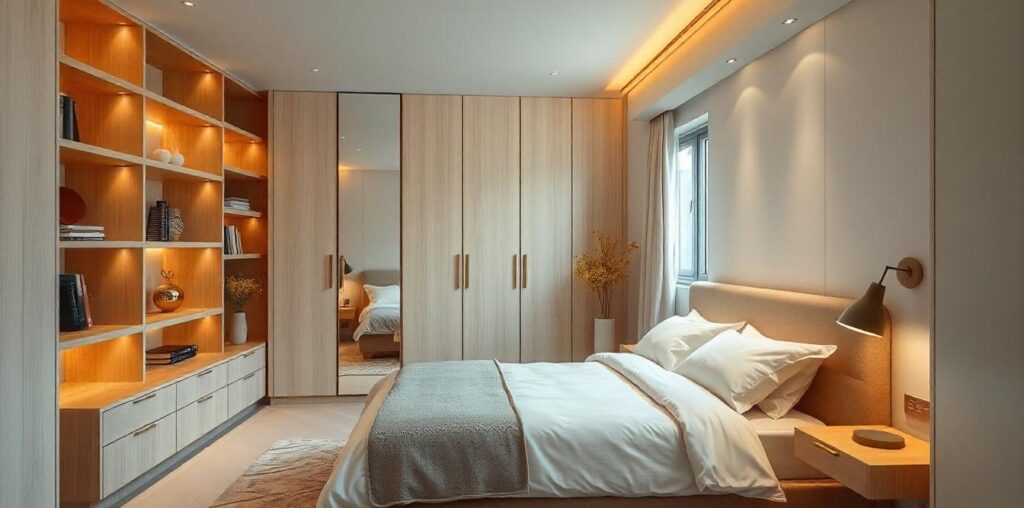Designing a small bedroom can be challenging, but with the right strategies, you can transform a compact space into a cozy, functional, and aesthetically pleasing retreat. This guide provides practical tips on how to interior design a small bedroom while maximizing space and maintaining style.
Understanding the Basics of Small Bedroom Interior Design
Designing a small bedroom requires creative problem-solving and smart space-saving techniques. The key is to focus on functionality without sacrificing comfort or visual appeal.
1. Choose a Smart Layout
Optimize Furniture Placement
Efficient layouts are crucial for small bedrooms. Consider placing the bed along one wall to free up walking space. Avoid positioning large furniture near doorways or windows.
Tips for Effective Layouts:
- Place the bed against a wall to maximize floor space.
- Use vertical space for shelves and storage units.
- Ensure clear walking paths to maintain a sense of openness.
Multifunctional Furniture
Invest in furniture that serves multiple purposes, such as a bed with built-in storage or a foldable desk.
Example: A storage bed can free up valuable floor space by eliminating the need for extra storage units.
2. Maximize Storage Solutions
Under-Bed Storage
One of the best ways to utilize space is by taking advantage of the area under the bed.
Ideas for Under-Bed Storage:
- Storage drawers or bins.
- Vacuum-sealed bags for seasonal items.
- Pull-out rolling storage boxes.
Wall-Mounted Shelves
Wall-mounted shelves offer extra storage without encroaching on floor space.
Tip: Use floating shelves to store books, decor, or essentials, keeping surfaces clutter-free.
Built-In Closets
Built-in closets can be custom-designed to fit the room’s dimensions, offering optimal storage without taking up extra space.
3. Use a Minimalist Color Scheme
Light Colors for a Spacious Feel
Light, neutral colors such as white, beige, or pastel shades can make a room feel larger and more open.
Recommended Color Palette:
- Soft whites and creams.
- Light grays and beiges.
- Pastel blues or greens for a touch of color.
Tip: Incorporate pops of color through accent pillows or artwork without overwhelming the space.
Mirrors to Create Illusion of Space
Mirrors reflect light and give the illusion of a larger room.
Tip: Place a large mirror opposite a window to maximize natural light.
4. Optimize Lighting
Lighting can dramatically impact the perception of space in a small bedroom. Use layered lighting to create depth and warmth.
Lighting Ideas:
- Overhead Lighting: Choose a compact, flush-mounted ceiling light.
- Task Lighting: Use wall-mounted reading lamps instead of bedside table lamps.
- Ambient Lighting: Add string lights or LED strips to create a cozy atmosphere.
Tip: Maximize natural light by using sheer curtains or blinds.
5. Select Space-Saving Furniture
Multifunctional Pieces
Select furniture designed for small spaces, such as:
- Beds with storage compartments.
- Foldable desks or wall-mounted workspaces.
- Ottomans that double as storage units.
Built-In Furniture
Built-in furniture, such as a custom desk or seating nook, can maximize available space while providing functionality.
6. Keep Decor Minimal and Strategic
Declutter Regularly
Clutter can make a small room feel even smaller. Keep surfaces clean and store items out of sight.
Wall Art and Decor
Limit wall decor to a few statement pieces to prevent the room from feeling overcrowded.
Plants for Freshness
Adding small plants can bring life to the room without taking up too much space.
7. Utilize Vertical Space
When floor space is limited, vertical storage solutions can be a lifesaver.
Vertical Storage Ideas:
- Tall bookshelves or cabinets.
- Wall-mounted organizers for clothing or accessories.
- Hanging storage units behind doors.
Tip: Install hooks or pegboards on walls to hang bags, hats, or jewelry.
8. Incorporate Textures and Patterns
Adding texture and subtle patterns can create depth and interest in a small bedroom without overwhelming the space.
How to Add Texture:
- Layer different fabrics, such as knitted blankets, cotton sheets, and velvet pillows.
- Choose patterned rugs or curtains to enhance the visual appeal.
Tip: Stick to smaller patterns and neutral tones to maintain a spacious feel.
9. Enhance Privacy and Functionality
In multi-purpose small bedrooms, privacy can be a concern. Create designated zones using dividers or curtains.
Room Dividers:
- Sliding panels or folding screens.
- Bookshelves acting as partitions.
- Ceiling-mounted curtains.
10. Personalized Touches
A small bedroom doesn’t have to feel generic. Add personalized touches to make it your own.
Personalization Ideas:
- Custom artwork or framed photos.
- Decorative pillows or throws.
- Unique lighting fixtures or bedside lamps.
Tip: Avoid overloading the room with decor; less is more in small spaces.
Example Application: Small Bedroom with a Bathroom Adjoining
If your small bedroom connects to an en-suite bathroom, designing both spaces cohesively can enhance the overall look. Consult a Bathroom Interior Design Company in Bangladesh for expert advice on creating a seamless transition between rooms.
Conclusion: Small Bedroom, Big Potential
Designing a small bedroom doesn’t mean compromising on style or comfort. By using smart furniture arrangements, space-saving solutions, and thoughtful design, you can create a functional and visually appealing space that maximizes every inch.


